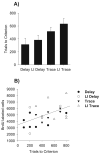Neurogenesis, learning and associative strength
- PMID: 18588540
- PMCID: PMC3289543
- DOI: 10.1111/j.1460-9568.2008.06222.x
Neurogenesis, learning and associative strength
Abstract
Though the role of the hippocampus in processes of learning and memory is well established, the role of new neurons generated there is less understood. Training on some associative learning tasks increases the likelihood that new cells in the subgranular zone of the dentate gyrus will survive. In the rat, an effective training procedure is trace eyeblink conditioning, in which a conditioned stimulus (CS) is paired with an aversive stimulation to the eyelid (unconditioned stimulus; US), but the stimuli are separated by a temporal gap. Here, we manipulated the asymptote or rate of acquisition during trace conditioning, and examined survival of cells generated 1 week before training. Acquisition was disrupted by decreasing associative strength by insertion of unpredicted USs or slowed with latent inhibition. The number of cells was increased in animals that were trained with trace conditioning, irrespective of the decrease in associative strength or slowed acquisition. Disrupting acquisition with unsignaled USs still increased cell numbers, suggesting that the learning effect on cell survival is not dependent on reliable expression of the conditioned response. Further, animals in the latent inhibition conditions that learned but required more trials also retained more of the new cells than animals requiring fewer trials. The number of cells that survived after the effective training procedures was similar to the number of cells that were available for rescue at the beginning of training. Thus, learning can rescue the majority of cells expressed at the beginning of training, and does so most effectively when acquisition requires many trials.
Figures





References
-
- Altman J, Das GD. Autoradiographic and histological evidence of postnatal hippocampal neurogenesis in adult rats. J Comp Neurol. 1965;124:319–335. - PubMed
-
- Beylin AV, Gandhi CC, Wood GE, Talk AC, Matzel LD, Shors TJ. The role of the hippocampus in trace conditioning: temporal discontinuity or task difficulty? Neurobiol Learn Mem. 2001;76:447–461. - PubMed
-
- Bolles RC, Collier AC, Bouton ME, Marlin NA. Some tricks for ameliorating the trace-conditioning deficit. Bull Psychon Soc. 1978;11:403–406.
-
- Cameron HA, McKay RD. Adult neurogenesis produces a large pool of new granule cells in the dentate gyrus. J Comp Neurol. 2001;435:406–417. - PubMed
-
- Cameron HA, Woolley CS, McEwen BS, Gould E. Differentiation of newly born neurons and glia in the dentate gyrus of the adult rat. Neuroscience. 1993;56:337–344. - PubMed
Publication types
MeSH terms
Grants and funding
LinkOut - more resources
Full Text Sources
Medical
Miscellaneous

